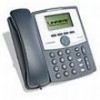Linksys SPA922 Cisco SPA9000 Voice System Web-UI Based Product Installation an - Page 15
Getting Started, Introduction to the SPA9000 Voice System
 |
UPC - 745883570836
View all Linksys SPA922 manuals
Add to My Manuals
Save this manual to your list of manuals |
Page 15 highlights
1 Getting Started This chapter introduces you to the SPA9000 Voice System by describing the components and presenting several deployment scenarios. NOTE This chapter is essential reading before you begin installing the equipment or configuring the system. • "Introduction to the SPA9000 Voice System," on page13 • "Deployment Scenarios," on page15 • "Introducing Components of the SPA9000 Voice System," on page 20 Introduction to the SPA9000 Voice System The SPA9000 Voice System is an affordable and feature-rich IP telephone system that is designed especially for the Small and Home Office. The SPA9000 Voice System uses standard TCP/IP protocols and can provide global connectivity through any Internet Telephony Service Provider (ITSP) that supports the Session Initiation Protocol (SIP). At minimum, the SPA9000 Voice System includes a SPA9000 IP PBX and one or more SPA900 series IP phones. These devices are connected through a switch to a local area network. With an Internet connection, the SPA9000 Voice System can subscribe to ITSP services to take advantage of low calling rates. With the SPA400, the SPA9000 Voice System can connect to the Public Switched Telephone Network (PSTN) to support analog phone lines. See Figure 1 "SPA9000 Voice System with the SPA9000 and SPA400" on page14 to learn more about a typical deployment. SPA9000 Voice System Installation and Configuration Guide for Web UI 13















